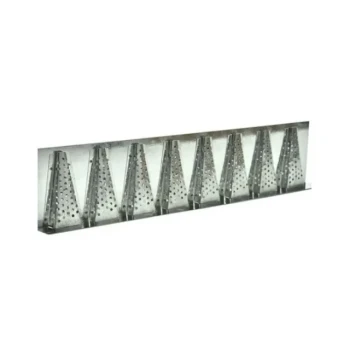At its core, a steel entrance disc is a simple, rotating gate for a beehive. It provides beekeepers with a straightforward method for controlling traffic and securing the colony by offering four distinct settings: fully open, queen exclusion, ventilation only, and fully closed.
This small piece of hardware is more than just a door; it is a versatile management tool that allows you to adapt the hive's entrance to specific situations, from protecting the queen and defending against pests to safely transporting the entire colony.

The Four Functions of a Hive Entrance Disc
The entrance disc's utility comes from its four rotational settings. Each one serves a distinct purpose, giving you precise control over who and what can enter or leave the hive.
1. Fully Open Access
This setting provides the largest possible opening. It is the default for a healthy, populous hive during periods of high activity, such as a major nectar flow.
A wide-open entrance prevents traffic jams as thousands of forager bees simultaneously leave and return, maximizing their efficiency.
2. The Queen Excluder Setting
This setting features a grid or slots large enough for worker bees to pass through but too small for the larger queen and drones.
Its primary use is to prevent a colony from swarming, as the old queen cannot leave with the departing bees. It is also essential for keeping a newly mated or virgin queen inside the hive until you are ready for her to fly. It can also offer a line of defense against larger robbers like wasps.
3. The Ventilation Setting
This option consists of small holes that allow for air exchange but are too small for any bees to pass through.
This function is critical when you need to move a hive. It prevents the colony from overheating while confined during transport. It can also provide draft-free ventilation during winter in certain management styles.
4. The Fully Closed Setting
The closed position completely seals the hive entrance, permitting nothing to enter or leave.
This is used for safely transporting the colony over short distances. It's also a vital emergency function to temporarily lock down the hive to protect it from nearby pesticide spraying or other immediate environmental threats.
Understanding the Trade-offs and Limitations
While incredibly useful, the entrance disc is not a perfect solution for every problem. Understanding its limitations is key to using it effectively.
Potential for Traffic Bottlenecks
Even the "fully open" setting on an entrance disc can be smaller than a standard hive's bottom entrance. For an exceptionally strong colony during a peak nectar flow, this can create a bottleneck that slightly reduces foraging efficiency.
Not a Comprehensive Pest Solution
The queen excluder setting can deter large wasps or hornets, but it does nothing to stop smaller pests. Varroa mites, wax moths, and small hive beetles can still enter freely. It is a traffic controller, not a complete pest barrier.
Risk of Misuse
Using the "closed" or "ventilation" setting improperly can endanger the colony. Sealing the hive on a hot day without the intention of moving it can cause rapid overheating and kill the bees. These settings are for temporary, specific situations.
Making the Right Choice for Your Goal
The entrance disc gives you flexible control over the hive. Your goal will determine which setting you should use.
- If your primary focus is moving your bees: Use the 'Ventilation' setting for long trips or the 'Closed' setting for very short ones to keep the colony secure and prevent overheating.
- If your primary focus is swarm management: Use the 'Queen Excluder' setting to confine the queen and prevent her from leaving with a swarm.
- If your primary focus is colony defense: Use the 'Queen Excluder' setting to reduce the entrance size, making it easier for a smaller colony to defend against robbers.
- If your primary focus is maximizing nectar collection: Use the 'Fully Open' setting to ensure forager bees can come and go without congestion.
This simple device empowers you to manage your hive proactively, adapting to the colony's needs throughout the season.
Summary Table:
| Setting | Primary Function | Key Use Case |
|---|---|---|
| Fully Open | Maximize forager traffic | Peak nectar flow |
| Queen Excluder | Confine queen, deter large pests | Swarm prevention, colony defense |
| Ventilation | Allow air exchange | Hive transport, winter ventilation |
| Fully Closed | Complete entrance seal | Short transport, emergency lockdown |
Ready to enhance your apiary management? The right equipment is key to a productive and secure operation. HONESTBEE supplies durable, commercial-grade beekeeping supplies and equipment—including entrance discs—to commercial apiaries and distributors through our wholesale-focused operations. Let us help you equip your hives for success. Contact our team today to discuss your needs and request a quote!
Visual Guide

Related Products
- Beehive Entrance Reducer Guardian Metal Hive Entrance for Bees
- Steel Round Disc Entrance Reducer for Flexzion Bee Hive Nuc Box Gate
- Multi-Functional Rotary Hive Entrance Disc for Beekeeping
- Multi-Functional Sliding Hive Entrance for Beekeeping
- Professional Ant-Proof Beehive Stand with Integrated Moat for Beekeeping
People Also Ask
- What should be done after transferring frames to the new hive? Essential Steps for a Secure Colony
- What are the features of the side with oblong holes in the entrance reducer? A Guide to Hive Defense & Health
- How can a Langstroth hive entrance be adjusted? Mimic Natural Bee Preferences for a Healthier Hive
- How big should a beehive entrance be? Optimize for Colony Health & Honey Production
- What are the different types of entrance reducers available? A Guide to Protecting Your Hive



















